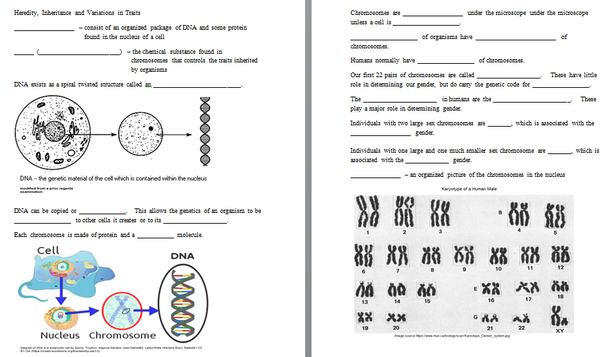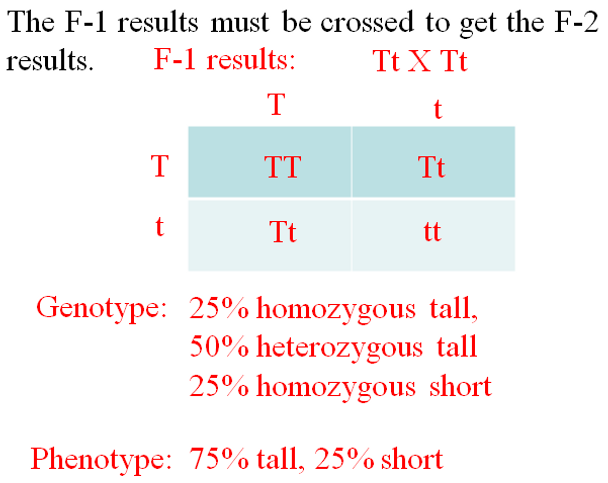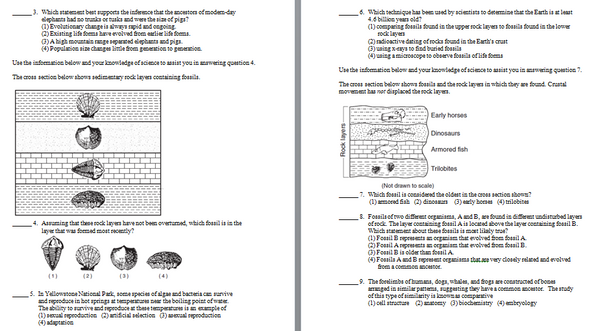Description
This product contains a zip file with fourteen different activities with supporting keys that provide the basis for a Middle School level Life Science Learning Unit on the topics of Heredity, Variations, Mendelian Genetics and Beyond. The activities within the file are correlated to the MS-LS 3-1 and MS-LS 3-2 NGSS Learning Standards.
Answer keys are included for all the student activities. The product contains 83 pages of student resources and 183 total PowerPoint slides. The Learning Standards and Learning Goals addressed by these activities can be viewed below the list of activities.
Topics include sources of variation, genes and chromosomes, an overview of protein synthesis, beneficial, neutral and harmful mutations, Mendelian Genetics, incomplete dominance, codominance, A-B-O blood group heredity and sex-linked crosses. Dihybrid crosses tend to be beyond the scope of most Middle Level Genetics courses and are not included in this package of activities.
The activities contained in the zip file are as follows:
- Heredity, Inheritance and Variation in Traits Scaffolded Completion Notes (10 pp.)
- PowerPoint to support the Scaffolded Completion Notes (27 slides)
- Mendelian Genetics Scaffolded Completion Notes (8 pp.)
- PowerPoint to support the Mendelian Genetics Scaffolded Completion Notes (28 slides)
- Inheritance and Variation Worksheet (50 completion questions/multiple choice questions) (5 pp.)
- Genetics Crosses Worksheet 1 (Mendelian Genetics) (47 completion, multiple choice and short answer questions) (9 pp.)
- Genetic Crosses Worksheet 2 (8 crosses and short answer questions) (2 pp.)
- Genetic Crosses Worksheet 2 PowerPoint Key (may be used to review worksheet with students) (9 slides)
- Marshmallow Creatures Genetics Activity (involves reading, writing and manipulation) (12 pages)
- Heredity, Inheritance and Variations in Traits quiz (40 matching, multiple choice and free response questions) (5 pp.)
- Mendelian Genetics Test (50 matching, multiple choice and short response questions) (7 pp.)
- Beyond Mendelian Genetics Scaffolded Completion Notes (6 pp.)
- PowerPoint to support the Beyond Mendelian Genetics Scaffolded Completion Notes (18 slides)
- Genetic Crosses Worksheet 3 (Incomplete Dominance and Codominance) (5 problems) (2 pp.)
- Genetic Crosses Worksheet 3 PowerPoint Key (5 slides)
- Genetic Crosses Worksheet 4 (A-B-O Blood Types and Sex-linked Crosses) (10 problems) (2 pp.)
- Genetic Crosses Worksheet 4 PowerPoint Teaching Key (22 slides)
- Genetics Worksheet 5 (Beyond Mendelian Genetics Crosses) (20 multiple choice questions) (3 pp.)
- Beyond Mendelian Genetics Quiz (33 questions) (6 pp.)
- Heredity, Inheritance and Variation Jeopardy (31 questions) (74 slides)
- NGSS, Common Core Learning Standards and Learning Goals (3 pp.)
NGSS Standards
MS-LS3 Heredity: Inheritance and Variation of Traits
Students who demonstrate understanding can:
MS-LS3-1. Develop and use a model to describe why structural changes to genes (mutations) located on chromosomes may affect proteins and may result in harmful, beneficial, or neutral effects to the structure and function of the organism.
MS-LS3-2. Develop and use a model to describe why asexual reproduction results in offspring with identical genetic information and sexual reproduction results in offspring with genetic variation.
Common Core State Standards Connections:
ELA/Literacy
RST.6-8.1 Cite specific textual evidence to support analysis of science and technical texts.
RST.6-8.4 Determine the meaning of symbols, key terms, and other domain-specific words and phrases as they are used in a specific scientific or technical context relevant to grades 6-8 texts and topics.
RST.6-8.7 Integrate quantitative or technical information expressed in words in a text with a version of that information expressed visually (e.g., in a flowchart, diagram, model, graph, or table).
SL.8.5 Include multimedia components and visual displays in presentations to clarify claims and findings and emphasize salient points.
Mathematics
MP.4 Model with mathematics.
6.SP.B.5 Summarize numerical data sets in relation to their context.
Learning Objectives (Heredity, Inheritance and Variation in Traits)
Upon the completion of this unit the student will be able to:
1. define the terms chromosome, gene and allele.
2. discuss the relationship between the cell nucleus, chromosomes and genes.
3. describe the shape of the DNA molecule.
4. briefly explain why DNA replication is important.
5. recognize humans normally have 23 pairs of chromosomes.
6. explain the difference between autosomes and sex chromosomes.
7. discuss differences in sex chromosomes in determining the gender of many people.
8. define the term karyotype.
9. briefly discuss how genes direct protein making by the ribosomes.
10. define the term mutation.
11. recognize the only mutations in gametes are passed on by sexually reproducing offspring.
12. explain how mutations may result in changes in organism traits.
13. recognize the offspring of sexually reproducing parents have many variations from the parents.
14. recognize meiosis is the process producing gametes in animals.
15. discuss two sources of genetic shuffling in meiosis.
16. list three sources of variation in sexually reproducing offspring.
17. define the term crossing over.
18. explain the roles of independent assortment, segregation and recombination in producing genetic variation.
19. define the terms fertilization and zygote.
20. recognize a zygote divides by mitosis to form a multicellular organism.
21. explain how neutral, beneficial and harmful mutations differ.
22. list two examples of helpful mutations.
23. list two examples of harmful mutations.
24. briefly discuss the role of checkpoint proteins.
25. describe some characteristics of cancer.
Learning Objectives (Mendelian Genetics)
Upon the completion of this unit the student will be able to:
1. recognize Mendel was the first person to use mathematics to analyze inherited traits.
2. define the term trait.
3. explain the difference between heredity and genetics.
4. define the terms dominant trait and recessive trait and explain how they are represented in a genetic cross.
5. define the terms genotype and phenotype.
6. define the following terms; homozygous, pure, heterozygous and hybrid.
7. use a Punnett square to represent and solve basic Mendelian crosses.
8. list several reasons Mendel was successful in analyzing the inheritance of garden pea traits.
9. explain what is meant by the parent, F-1 and F-2 generation.
10. explain what a test cross (back cross) is and describe how it is used.
11. state Mendel's law of dominance.
12. state Mendel's law of segregation.
13. relate the processes of segregation and recombination to meiosis and fertilization.
14. state Mendel's law of independent assortment.
15. list an exception to Mendel's law of independent assortment.
Learning Objectives (Beyond Mendelian Genetics)
Upon the completion of this unit the student will be able to:
1. describe heredity involving incomplete dominance and list some examples of this.
2. describe heredity involving codominance and list some examples of this.
3. perform and describe the results of genetic crosses involving incomplete dominance or codominance.
4. discuss A-B-O blood group inheritance.
5. perform and describe the results of genetic crosses involving A-B-O blood group inheritance.
6. explain what a sex-linked gene is.
7. describe how to represent various allele combinations in sex-linked crosses.
8. list several examples of sex-linked hereditary conditions.
9. perform and describe sex-linked hereditary crosses.
Terms of Use
Purchase of the product is for classroom use by the purchaser only. It is a violation for individuals, schools, and districts to redistribute or sell this item on the Internet or to other individuals. I do encourage you to use and edit these documents to suit your needs with your own students in distance learning environments.
This work is licensed under a Creative Commons Attribution-NonCommercial-ShareAlike 4.0 International License.
View many more great science resources at Monday's Rescue.


























